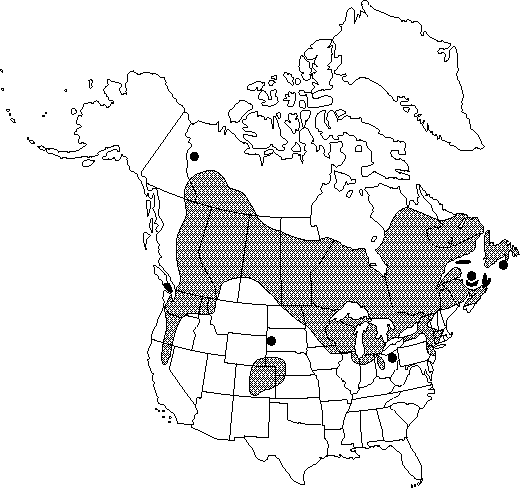Difference between revisions of "Betula pumila"
Mant. Pl., 124. 1767.
FNA>Volume Importer |
GeoffLevin (talk | contribs) m (Fixed Nfld. and Labr. distribution to match map in printed version.) |
||
| (3 intermediate revisions by 2 users not shown) | |||
| Line 67: | Line 67: | ||
|habitat=Bogs, calcareous fens, wooded swamps, muskegs, lake shores | |habitat=Bogs, calcareous fens, wooded swamps, muskegs, lake shores | ||
|elevation=0–700 m | |elevation=0–700 m | ||
| − | |distribution=St. Pierre and Miquelon;Alta.;B.C.;Man.;N.B.;Nfld.;N.W.T.;N.S.;Ont.;P.E.I.;Que.;Sask.;Yukon;Calif.;Colo.;Conn.;Idaho;Ill.;Ind.;Iowa;Kans.;Maine;Mass.;Mich.;Minn.;Mont.;Nebr.;N.J.;N.Y.;N.Dak.;Ohio;Oreg.;Pa.;S.Dak.;Vt.;Wash.;Wis.;Wyo. | + | |distribution=St. Pierre and Miquelon;Alta.;B.C.;Man.;N.B.;Nfld. and Labr.;N.W.T.;N.S.;Ont.;P.E.I.;Que.;Sask.;Yukon;Calif.;Colo.;Conn.;Idaho;Ill.;Ind.;Iowa;Kans.;Maine;Mass.;Mich.;Minn.;Mont.;Nebr.;N.J.;N.Y.;N.Dak.;Ohio;Oreg.;Pa.;S.Dak.;Vt.;Wash.;Wis.;Wyo. |
|discussion=<p><i>Betula pumila</i> is sometimes treated (in part) as a variety of <i>B. glandulosa</i> Michaux, to which it is related at a subgeneric or sectional level. On the basis of morphology, however, it forms a cohesive and distinct entity (J. J. Furlow 1984). The two main varieties into which <i>B. pumila</i> is often divided (a more southern <i>B. pumila</i> <i></i>var.<i> pumila</i>, with mostly pubescent, glandless leaves, and a more northern <i>B. pumila</i> <i></i>var.<i> glandulifera</i>, with less pubescent, gland-bearing leaves) may represent geographic races; these are not well marked, however, and they do not hold up well when the complex is examined as a whole.</p><!-- | |discussion=<p><i>Betula pumila</i> is sometimes treated (in part) as a variety of <i>B. glandulosa</i> Michaux, to which it is related at a subgeneric or sectional level. On the basis of morphology, however, it forms a cohesive and distinct entity (J. J. Furlow 1984). The two main varieties into which <i>B. pumila</i> is often divided (a more southern <i>B. pumila</i> <i></i>var.<i> pumila</i>, with mostly pubescent, glandless leaves, and a more northern <i>B. pumila</i> <i></i>var.<i> glandulifera</i>, with less pubescent, gland-bearing leaves) may represent geographic races; these are not well marked, however, and they do not hold up well when the complex is examined as a whole.</p><!-- | ||
--><p>The Ojibwa used <i>Betula pumila</i> medicinally as a gynecological aid and as a respiratory aid (D. E. Moerman 1986).</p> | --><p>The Ojibwa used <i>Betula pumila</i> medicinally as a gynecological aid and as a respiratory aid (D. E. Moerman 1986).</p> | ||
| Line 87: | Line 87: | ||
|habitat=Bogs, calcareous fens, wooded swamps, muskegs, lake shores | |habitat=Bogs, calcareous fens, wooded swamps, muskegs, lake shores | ||
|elevation=0–700 m | |elevation=0–700 m | ||
| − | |distribution=St. Pierre and Miquelon;Alta.;B.C.;Man.;N.B.;Nfld.;N.W.T.;N.S.;Ont.;P.E.I.;Que.;Sask.;Yukon;Calif.;Colo.;Conn.;Idaho;Ill.;Ind.;Iowa;Kans.;Maine;Mass.;Mich.;Minn.;Mont.;Nebr.;N.J.;N.Y.;N.Dak.;Ohio;Oreg.;Pa.;S.Dak.;Vt.;Wash.;Wis.;Wyo. | + | |distribution=St. Pierre and Miquelon;Alta.;B.C.;Man.;N.B.;Nfld. and Labr.;N.W.T.;N.S.;Ont.;P.E.I.;Que.;Sask.;Yukon;Calif.;Colo.;Conn.;Idaho;Ill.;Ind.;Iowa;Kans.;Maine;Mass.;Mich.;Minn.;Mont.;Nebr.;N.J.;N.Y.;N.Dak.;Ohio;Oreg.;Pa.;S.Dak.;Vt.;Wash.;Wis.;Wyo. |
|reference=None | |reference=None | ||
|publication title=Mant. Pl., | |publication title=Mant. Pl., | ||
|publication year=1767 | |publication year=1767 | ||
|special status=Endemic | |special status=Endemic | ||
| − | |source xml=https:// | + | |source xml=https://bitbucket.org/aafc-mbb/fna-data-curation/src/2e0870ddd59836b60bcf96646a41e87ea5a5943a/coarse_grained_fna_xml/V3/V3_681.xml |
|subfamily=Betulaceae subfam. Betuloideae | |subfamily=Betulaceae subfam. Betuloideae | ||
|genus=Betula | |genus=Betula | ||
Latest revision as of 14:19, 29 February 2024
Shrubs, coarse, irregular, or spreading, to 4 m. Bark dark reddish brown, smooth, close; lenticels pale, inconspicuous. Twigs without taste and odor of wintergreen, glabrous to moderately pubescent, with scattered small resinous glands, especially near nodes. Leaf blade elliptic, obovate, or nearly orbiculate (to sometimes reniform) with 2–6 pairs of lateral veins, 2.5–5(–7) × 1–5 cm, base cuneate to rounded, margins crenate to dentate, apex usually broadly acute or obtuse to rounded; surfaces abaxially glabrous or slightly pubescent to heavily velutinous or tomentose, often with scattered resinous glands. Infructescences erect, cylindric, 0.8–1.5(–2) × 0.8–1 cm, shattering with fruits in fall; scales glabrous to pubescent, lobes diverging slightly distal to middle, central lobe narrow, elongate, lateral lobes shorter and broader, extended. Samaras with wings slightly narrower than body, broadest near center, not extended beyond body apically. 2n = 56.
Phenology: Flowering late spring.
Habitat: Bogs, calcareous fens, wooded swamps, muskegs, lake shores
Elevation: 0–700 m
Distribution

St. Pierre and Miquelon, Alta., B.C., Man., N.B., Nfld. and Labr., N.W.T., N.S., Ont., P.E.I., Que., Sask., Yukon, Calif., Colo., Conn., Idaho, Ill., Ind., Iowa, Kans., Maine, Mass., Mich., Minn., Mont., Nebr., N.J., N.Y., N.Dak., Ohio, Oreg., Pa., S.Dak., Vt., Wash., Wis., Wyo.
Discussion
Betula pumila is sometimes treated (in part) as a variety of B. glandulosa Michaux, to which it is related at a subgeneric or sectional level. On the basis of morphology, however, it forms a cohesive and distinct entity (J. J. Furlow 1984). The two main varieties into which B. pumila is often divided (a more southern B. pumila var. pumila, with mostly pubescent, glandless leaves, and a more northern B. pumila var. glandulifera, with less pubescent, gland-bearing leaves) may represent geographic races; these are not well marked, however, and they do not hold up well when the complex is examined as a whole.
The Ojibwa used Betula pumila medicinally as a gynecological aid and as a respiratory aid (D. E. Moerman 1986).
Selected References
None.